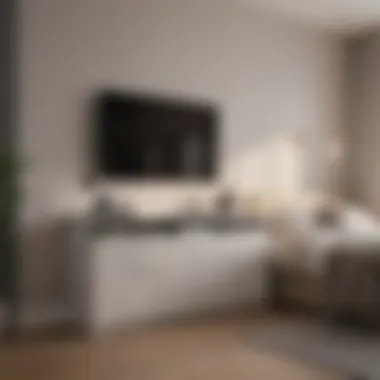Maximizing Storage Solutions in Small Bedrooms


Intro
Living in a small bedroom can feel like slipping into a tight pair of shoes—uncomfortable and limiting. However, with some creativity and careful planning, one can transform any compact space into an organized and stylish haven. In this guide, we dive deeply into strategies that maximize storage in limited bedroom spaces, making sure you can squeeze in both your essentials and personal touches without missing a beat.
Modern urban living often means dealing with less square footage. This article discusses practical and innovative approaches that help you capitalize on every inch of your bedroom, from vertical storage ideas to multifunctional furniture selections. While simplicity is key, finding a way to incorporate aesthetics into your storage solutions can make a world of difference, turning a cluttered space into a calm retreat.
"A place for everything and everything in its place" may ring a bell here. The goal is not just to stash away items but to create a harmonious living environment that speaks to both organization and style.
Featured Homes
This section explores how various homes around the world have brilliantly solved the issue of storage in smaller bedrooms. Whether through clever architectural decisions or ingenious design elements, let’s delve into the inspiring solutions found in unique spaces.
Architectural Styles
In many busy cities, compact living spaces have led to unique architectural solutions. For instance, Scandinavian designs often include built-in shelves and smart nooks, utilizing wall space for hidden storage. This approach not only saves space but also adds character to the room. Similarly, Japanese homes frequently incorporate tatami mats, which double as both flooring and storage with drawers underneath, embodying minimalism and functionality.
Unique Design Elements
One fascinating design element found in some loft apartments is the use of open shelving systems that blend practicality with personalization. Homeowners can display books and decorative items while keeping everyday belongings organized. A pegboard can also serve as a great multifunctional tool. It can hold everything from jewelry to office supplies, ingeniously reducing clutter while being visually stimulating—which is perfect for a small bedroom.
Creative Furniture Solutions
When it comes to storage, furniture plays a vital role—especially when it does double duty. For instance, a bed with drawers underneath is a classic example of how to maximize space. Storage ottomans or benches are also great for stowing away blankets or seasonal clothing while providing additional seating.
Floating desks and wall-mounted shelves can free up floor space, while also offering an aesthetically pleasing display area. The beauty of multifunctional furniture is it encourages you to stay organized, ensuring that every item has its designated spot.
Clever Organizational Techniques
Lastly, it’s essential to think about organization techniques that can make a small bedroom work like a charm. Start by decluttering your belongings—less is more. Utilizing clear storage bins allows you to keep items visible but contained, preventing chaos from taking over.
Consider vertical storage solutions such as hanging organizers for shoes or accessories. Over-the-door storage systems can be a game changer for small spaces, effectively turning doors into additional storage areas for bags, towels, or cleaning supplies.
Understanding the Challenges of Small Bedrooms
When it comes to small bedrooms, the challenges can feel insurmountable at times. Knowing how to navigate these hurdles is paramount for creating a space that is both functional and serene. Every inch in these compact realms counts, and understanding these challenges helps in laying the groundwork for clever solutions that will maximize that tight space.
Identifying Common Storage Issues
Small bedrooms often come with their own set of common storage problems. Limited floor space means every piece of furniture and every item in your space needs thoughtful consideration. Here are a few issues often encountered:
- Insufficient closet space: Many small bedrooms come with closets that simply can’t hold the variety of clothes and accessories one owns. It’s like trying to fit a round peg into a square hole, only to find there’s no hole at all.
- Limited shelving options: Walls that ideally should showcase shelves may be swallowed by bulky furniture. It’s frustrating when all your favorite books or decor pieces have to sit in boxes instead.
- Difficulty in accessing items: When a bedroom lacks adequate storage solutions, you find yourself playing a game of Tetris with your belongings. Getting to that sweater you really love becomes a chore rather than a delight.
Understanding these issues is crucial, as it prepares you to tackle the clutter and disorganization head-on. You can’t solve a problem if you don’t know it's there.
The Impact of Clutter on Living Spaces
Clutter is an uninvited guest in small spaces. Not only does it make everything feel chaotic, but it can also weigh down the mind. A room filled to the brim with items can lead to feelings of anxiety—think of it as mental baggage that makes your mind feel foggy.
"A cluttered room is not just an eyesore; it affects the psyche too. Taking the time to disentangle the mess can increase your quality of life."
Moreover, clutter can limit functionality. A bed piled high with laundry won’t be conducive to a good night’s sleep, and a desk buried in paperwork can render work tasks daunting. Think about these scenarios:
- Difficulties in finding items: When everything is out of sorts, it’s a hassle to locate the things you need, making routine tasks mere obstacles.
- Reduced relaxation: A cluttered, chaotic environment is a stressor that takes away from your ability to unwind. Instead of feeling at home, you may feel like a guest in your own room.
In essence, tackling the clutter in small bedrooms is not just about aesthetics; it's about reclaiming your mental space and transforming your bedroom into a sanctuary.
Assessing Your Needs and Priorities
Taking the time to assess your needs and priorities is a fundamental step in maximizing storage in small bedroom spaces. Without understanding what's essential for your daily life, your efforts in organizing and optimizing space might end up being counterproductive. The goal is to establish clarity on what truly matters to you, which helps in making informed decisions on storage solutions.
By prioritizing essential items, you can ensure that your limited space serves your lifestyle efficiently. It’s not just about fitting more things; it’s about enhancing your living experience. A focused approach can reduce overwhelming clutter and contribute to a more pleasant environment.
Evaluating Essential Items
To begin this evaluation, it's prudent to start with a thorough inventory of your belongings. Think about what you actually use and need daily. Some guiding questions include:
- What items do I use every day?
- Are there items that have sentimental value?
- Which belongings have I not used in months?
When assessing essential items, consider creating categories based on utility, such as:
- Daily essentials (clothing, toiletries, etc.)
- Occasional use items (seasonal clothing, special occasion décor)
- Sentimental belongings (gifts, family heirlooms)
This kind of categorization fosters a clearer appreciation of your essentials versus items that merely take up real estate in your space. If something hasn't seen the light of day for quite some time, it might be a good candidate for donation or disposal.
"Assessing what’s truly essential not only clears physical space but also frees up mental bandwidth."


Determining Frequency of Use
Determining how often you use certain items is equally critical. This assessment can help you decide what needs prime placement and what can be tucked away. Begin this process by answering:
- Do I reach for this item regularly, or is it stashed away most days?
- If I need this, how quickly can I access it?
Once you've identified how often you use specific items, categorize them like this:
- Regularly used: Items that make everyday life easier.
- Intermittently used: Things that are beneficial but not needed all the time.
- Rarely used: Those items that might be better suited for storage elsewhere or given away.
To keep your environment streamlined, aim to reserve valuable (and precious) space in your bedroom for those items you reach for the most. As you adapt to this systematic approach, you’ll likely find yourself feeling less overwhelmed and even more in control of your living space.
Applying these strategies not only helps create a more organized bedroom but can lift your overall mood and productivity too. Streamlining storage based on your unique needs and habits is a step toward curating a truly functional and supportive living environment.
Clever Furniture Choices
Selecting the right furniture can make or break the mood and functionality of a small bedroom. Living in limited space often requires a keen eye for creative solutions. Smart furniture not only enhances storage but also contributes to a room's style, making it an essential part of maximizing limited storage capacity. Clever furniture choices lead to a less cluttered and more organized environment, allowing individuals to live comfortably without feeling cramped. Incorporating furniture that serves multiple purposes can significantly optimize the available space and provide surprising benefits.
Opting for Multifunctional Furniture
Murphy Beds
Murphy Beds stand out due to their unique ability to save space when not in use. The main characteristic of a Murphy bed is its design, which allows it to fold up into the wall. This is particularly helpful in smaller rooms, making it easy to free up floor space during the day. The bed transforms into a beautiful wall piece, offering both function and aesthetic appeal.
The versatility of Murphy beds is often seen as a significant advantage. They are available in various styles and finishes, which can complement the room's decor while providing a practical sleeping solution. On the flip side, installing a Murphy bed can be more complex than traditional beds, often requiring professional assistance, and there’s always the potential for mechanical issues over time.
Storage Ottomans
Another clever choice is Storage Ottomans. These pieces are popular for adding an extra layer of storage without sacrificing comfort or style. The main appeal lies in their ability to act as both a seat and a hidden storage compartment. This duality is very advantageous when their storage function is used to stow away blankets, magazines, or even shoes, ultimately reducing visible clutter.
One unique feature of Storage Ottomans is their design adaptability; they can seamlessly blend into a room as coffee tables or footrests. However, it’s essential to consider the size, as overstuffed options may take up more floor space than expected, potentially hindering movement in tighter rooms.
Convertible Desks
Convertible Desks provide yet another innovative solution to space constraints. These desks change shape based on the user’s needs, which is a crucial aspect of their design. They are perfect for students or remote workers who might need a larger workspace intermittently. This flexibility means you can easily transition from a compact writing station to an expanded work area.
The standout characteristic of Convertible Desks is their functionality paired with style. Many models come equipped with shelves or additional drawers, enhancing their usage while maintaining a clean look. However, one disadvantage could be that some convertible models may lack stability when they are extended, and not all are designed for heavy equipment, limiting their utility for certain tasks.
Choosing Furniture with Built-in Storage
Bed Frames with Drawers
Bed Frames with Drawers are another smart consideration. These frames are crafted with integrated compartments underneath for storing personal items. The characteristic that makes them especially valuable is the utilization of a typically wasted space—under the bed—providing an efficient way to keep items out of sight yet easily accessible.
They are an effective solution for those looking to reduce bedroom clutter while still having essential items around. However, while they provide ample space, the depth of the drawers may limit what you can store, and you might find yourself needing to clean out the drawers regularly to prevent items from getting lost in the pile.
Dressers with Shelves
Lastly, Dressers with Shelves serve a dual purpose that aligns perfectly with a limited-space philosophy. Combining drawer space with shelving allows users to display items while keeping clothing organized. This design feature is beneficial for showcasing decorative elements or easily reachable essentials.
The versatility of Dressers with Shelves gives them more than just utility; they can enhance the aesthetic of a room. Yet it is crucial to arrange these pieces carefully since overcrowding the shelves can lead to a chaotic look, which is counterproductive in a small space.
Tip: Always measure your space before making any furniture purchase to ensure a good fit without overcrowding.
Choosing the right furniture can significantly impact how a small bedroom feels and functions. Multifunctional pieces and built-in storage options ensure that space is used wisely. By considering practical choices like Murphy Beds, Storage Ottomans, Convertible Desks, Bed Frames with Drawers, and Dressers with Shelves, one can create a well-organized environment that minimizes clutter and maximizes style.
Utilizing Vertical Space
In small bedrooms, floor space can often be a premium. This makes taking advantage of vertical space not just a clever idea, but a necessity. By strategically using the height of your room, you can create more storage options without overwhelming the space. Maximizing vertical space allows you to declutter surfaces, making a room feel more open. Here are a couple perspectives to keep in mind when you’re thinking about this important element in a small bedroom.
Installing Shelves at Varying Heights
Shelves are like the Swiss Army knives of storage solutions. They come in many styles and configurations, and the best part is that they can be installed at heights that suit your needs. For instance, if you use the upper shelves for things you don’t access daily, like seasonal decor or spare linens, you can keep the lower shelves for more frequently used items. This layered approach can help you maximize every inch of wall space.
- Tip: Use floating shelves to give a sleek and modern look. They don’t need brackets, so they can appear to float, contributing to a more open feel in the room.
- Consideration: Remember to balance functionality. It wouldn’t do you much good if you have to get out the ladder every time you need to reach something stored high up. Keeping frequently used items within arm’s reach is crucial for ease of access.
Hanging Organizers and Hooks
Hanging organizers are another smart move in small bedrooms. They take advantage of wall space for storage in a way that's flexible and can be changed as needs evolve. Think about using wall-mounted hooks for anything from bags to hats.
- Pocket organizers can hang behind doors or on walls, providing space for items like shoes, accessories, or even cables. They free up floor and drawer space, making it easier to find what you need without fuss.
For an added touch of flair and practicality, consider combining decorative hooks with a hanger style. This not only stores items but also adds character to your walls.
"Using vertical storage options can not only ensure that everything has its place but also breathe life back into a cramped room."


In summary, utilizing vertical space isn’t just a smart strategy but essential for enhancing your living area in a compact bedroom. By installing shelves at varying heights and using hanging organizers, you can carve out practical storage solutions while maintaining a stylish ambiance. Engaging with the vertical dimensions of your space can make all the difference, turning a cramped environment into an organized oasis.
Creative Storage Solutions
When living in a compact bedroom, savvy storage solutions become the unsung heroes of organization. Utilizing creative storage options not only frees up valuable floor space but also enhances the overall aesthetic of your personal sanctuary. Rethinking storage can transform cluttered corners into functional, stylish areas, making it easier to keep the essentials within reach while still retaining an orderly environment.
Under Bed Storage Options
Plastic Bins
Plastic bins are one of those storage mainstays that blend practicality with versatility. By tucking them under the bed, you unlock a trove of hidden storage without sacrificing space. Their lightweight nature stands out, allowing you to easily slide them in and out as needed.
A key benefit of plastic bins is their water-resistant feature, making them suitable for storing seasonal clothing and linens. Their clear design lets you peek inside to quickly find what you need, minimizing the fuss. Though they are generally durable, one downside might be their tendency to collect dust if not sealed well.
In a nutshell, plastic bins are a popular choice for balancing accessibility and protection of your belongings.
Rolling Drawers
Rolling drawers, on the other hand, bring a touch of ingenuity to under-bed storage. They glide easily, providing seamless access to materials that would otherwise be tucked away and forgotten. This versatility is a distinct advantage, as sliding them out can be done effortlessly, even in tight spaces.
These drawers come in a range of sizes, allowing you to select options that fit perfectly in your particular bedroom layout. A minor drawback could be the occasional need for careful maneuvering if they are stocked too heavily. However, the convenience of having your items at your fingertips outweighs such issues for many.
Using the Inside of Closet Doors
Pocket Organizers
Utilizing the inside of closet doors can become a game-changer for maximizing storage. Pocket organizers hang neatly on these doors, offering a smorgasbord of storage opportunities. They’re particularly savvy for managing shoes, accessories, and miscellaneous items, which usually create a chaotic situation on the floor or shelves.
Their greatest characteristic is the various pockets they feature, allowing for categorization that can simplify your daily routine. An outstanding benefit is their inexpensive price point, making this a popular solution for budget-conscious individuals. However, a point of consideration is that they may not hold heavier items well, so it's best to stick to lighter possessions.
Hooks for Accessories
Hooks for accessories fit in perfectly with a closet door setup. These small yet mighty pieces provide an effortless way to hang scarves, bags, and jewelry, ensuring everything is within arm's reach while keeping the space tidy.
The ease of use is a highlight here; just a simple hook suffices to hold your belongings, taking up virtually no space. They are often affordable, which further adds to their appeal in any storage solution plan. Still, those wishing to hang bulkier items may want to think twice, as hooks have their limits.
Ultimately, the combination of pocket organizers and hooks transforms wasted space into organized storage, enhancing the functionality of cramped closets.
Maximizing Closet Space
Maximizing closet space is a fundamental aspect of creating an organized and functional small bedroom. Limited storage can quickly lead to disorder, making a room feel cramped and chaotic. The closet, often seen as just a confined storage area, can transform into a treasure trove of efficiency when optimized correctly. With proper organization, it allows easy access to items while providing a visually pleasing environment.
Utilizing every nook and cranny of your closet not only enhances your room’s aesthetic but also makes your daily routine simpler. After all, who wants to dig through a pile of clothes every morning? Here are two key strategies to consider that can indeed make a tangible difference.
Implementing Closet Organizers
Organizers are your best friends in a small bedroom. They can be the ultimate game-changer when it comes to maximizing closet space. Think about integrating various types of organizers for distinct needs. This could be shelves for shoes, racks for accessories, and bins for seasonal items. Hooks, too, often underappreciated, can hold bags or scarves conveniently, freeing up shelf space for other essentials.
To illustrate, consider the use of vertical dividers within the closet.
- Adjustable shelves can adapt to your needs, allowing for changes as your wardrobe evolves.
- Hanging organizers help keep smaller items in check; they ensure that nothing is lost to the depths of your closet.
With these tools, what was once a cluttered closet turns into an ordered space, making it easy to find just what you need, when you need it.
Seasonal Clothing Rotation
Another vital practice is seasonal clothing rotation. This tactic involves changing out your clothes based on the time of year. Many individuals overlook how much space seasonal items consume, and this can lead to an overcrowded closet. By only keeping clothes relevant to the current season in the main space, you can free up considerable room.
When the colder months roll in, for example, you might replace summer attire with warmer sweaters and jackets. Shoving off the heavy winter coats for the light summer dresses creates an inviting atmosphere and maximizes your closet utility.
Some additional tips include:
- Use vacuum-sealed bags for winter clothes when they're not in use. This technique not only saves space but protects fabric from damage.
- Label boxes clearly based on the season. Knowing where items are means you're not hunting through piles each time the weather changes.
"An organized closet not only simplifies your life but cultivates a peaceful mindset, setting the tone for your entire room."
Embracing these strategies leads not just to more space but also to a more thoughtful approach to what you own and how you live. So next time you’re tackling storage issues, don’t forget about your closet's hidden potential.
Implementing Efficient Organization Techniques
By implementing efficient organization techniques, you can:
- Enhance accessibility: Quick access to essential items curbs frustration during those rushed mornings.
- Improve aesthetics: A tidy space not only feels better but also looks better, boosting overall mood and relaxation.
- Save time: Finding things easily contributes to smoother routines and less stress, freeing up time for other pursuits.
Categorizing Items for Easy Access


The first step to achieving a well-ordered bedroom is to categorize items based on usage, functionality, or type. This method allows you to quickly locate what you need without rummaging through piles. Here are some effective categorization strategies:
- Group by Function: Keep similar items together. For instance, place all reading materials on one shelf or in a specific drawer. This way, you know just where to grab your latest book when settling in for the night.
- Usage Frequency: Store items you use daily within easy reach. Seasonal items or rarely used objects can go higher up on shelves or in harder-to-reach areas. Think about moving your ski gear to the back of the closet during summer months.
- Create Zones: Designate areas in your bedroom for specific activities. Have a dedicated spot for work, another for relaxation, and perhaps one for hobbies. This will not only keep items organized but also sets a clear mental space for various activities.
Incorporating these practices will significantly ease the strain of locating personal items in a small room.
Labeling Storage Containers
Once you've sorted everything, it's vital to maintain that order. Labeling storage containers can play an essential part in this. A straightforward label can save time and prevent confusion. Here are ways to effectively label your storage:
- Use Clear Containers: If possible, opt for transparent bins. Seeing what's inside at a glance eliminates the need to waste time opening every box to find your favorite sweater.
- Descriptive Labels: Create labels that specify what’s within each container. Instead of just "clothes," opt for "winter clothes" or "office wear." This clarity can expedite the retrieval process.
- Duration of Use Tags: Some items are seasonal or only used occasionally. Consider labeling bins with timeframes, such as "Holiday Decorations" or "Summer Sports Gear."
"A place for everything and everything in its place" isn’t just a saying; it’s a guiding principle that eases daily living.
In brief, mastering organization through categorization and labeling is about more than just aesthetics—it improves functionality and enhances your quality of life in small spaces. With thoughtful consideration, anyone can create an efficient, organized bedroom that reflects both practicality and personal style.
The Role of Aesthetics in Small Bedrooms
When it comes to small bedrooms, the importance of aesthetics cannot be overlooked. A well-designed space goes beyond mere functionality; it transforms the room into a sanctuary that reflects personal style while also optimizing limited space. Aesthetics provide a sense of comfort and warmth, turning a cramped environment into a more inviting place to rest and recharge. It’s all about striking a balance between how things look and how they work.
Balancing Functionality with Style
In a limited bedroom, furniture and decor must serve dual purposes. For instance, a sleek, stylish nightstand can also provide storage for books and personal items. The challenge is to find pieces that don’t just fit the room’s requirements but also complement its design. Integrating functionality into style is crucial. You want pieces that are visually appealing yet serve a practical role. A minimalist approach is often beneficial here, avoiding overcrowded spaces while maintaining an orderly appearance.
Incorporating Design Elements to Enhance Space
Color Schemes
The color scheme used in small bedrooms plays a significant role in how spacious the room feels. Lighter colors like soft whites, pale blues, or gentle greens can create an illusion of openness, making the room seem larger than it really is. Conversely, darker hues can make a space feel cozy but might also close it off, creating a sense of confinement. It’s wise to balance these colors with accents that pop, adding visual interest without overwhelming the small space. Moreover, the key characteristic of light colors is their reflective quality, which enhances natural light and fosters a bright environment. Their unique feature is adaptability; they act as a perfect canvas for other design elements. However, some might find that these colors feel sterile or lack personality. Strategically placed bolder elements can invigorate the palette without overpowering the senses.
Decorative Accessories
Decorative accessories are vital for infusing personality into small bedrooms without sacrificing space. Items like artwork, throw pillows, and decorative mirrors can add layers and dimensions to the room’s aesthetic. Mirrors, especially, have a dual role—they can reflect light and create a perception of depth. This key characteristic makes mirrors a popular choice; they brighten up the room and visually expand the space. The unique feature of decorative accessories is their ease of change; you can swap them out with the seasons or when you feel like a fresh look is needed, providing versatility without committing to larger pieces of furniture. However, it’s essential for them to be chosen wisely to avoid creating a cluttered look, which can defeat the purpose of an aesthetically pleasing environment.
"A well-organized room is a reflection of how organized your mind is. A clear space leads to a clear mind."
In summary, aesthetics in small bedrooms hinge on the thoughtful integration of design elements that harmonize functionality and style. Color schemes and decorative accessories are primary tools in shaping this balance. By choosing wisely, you can create a space that not only meets your needs but also resonates with your personal taste.
Creating a Minimalist Environment
A minimalist environment in a small bedroom isn't just about having fewer things; it's about creating a space that feels open and inviting. In the hustle and bustle of modern life, the need for simplicity can become paramount. You don't have to be a monk to appreciate the benefits of minimalism; even small changes can lead to significant improvements in how you feel about your living space. This approach creates a sense of calm and order, making the most of your limited bedroom space.
Evaluating What to Keep and Dismiss
Sorting through belongings is often easier said than done. To effectively embrace minimalism, one must start with a critical evaluation of what’s actually necessary.
- Develop Criteria: Start by asking yourself questions about each item. Does it serve a purpose? Do you love it? Is it functional? This self-questioning helps separate the wheat from the chaff, making it easier to decide what deserves a place in your small room.
- Create Categories: Divide items into groups based on their use or emotional connection. Categories might include essentials, keepsakes, and items that haven’t seen the light of day for ages. By categorizing, you can visually assess what fills up room too much.
- Trial Period: For those sentimental objects, consider a trial period. Place them in a box and if you don’t retrieve them within a few months, it’s safe to say they can be donated or discarded.
This method helps in reducing clutter while allowing for a more curated and intentional living space.
Understanding the Benefits of Minimalism
Beyond just aesthetics, the benefits of minimalism run deep. It’s more than just freeing up space; it's about creating a lifestyle that prioritizes what truly matters.
- Less Stress: A decluttered space often translates to a decluttered mind. Less visual noise makes it easier to focus and feel at peace in your environment.
- Improved Functionality: With fewer items around, the ones you do keep gain importance. You can appreciate their utility without the distraction of excess.
- Easier Maintenance: A minimalist approach means fewer items to clean and manage. Dusting shelves packed with random trinkets takes more time compared to a streamlined setup.
"Embracing minimalism provides not just physical space but emotional clarity, reminding us to fill our lives with things that genuinely matter."
In a world craving authenticity, minimalism connects deeply with real estate enthusiasts and interior design aficionados. It allows one to articulate personal style while also navigating the challenges of space constraints. Embrace the notion that less can truly be more, and you’ll be on your way to cultivating a vibrant yet serene atmosphere in your small bedroom.
Incorporating Technology for Storage Solutions
In today’s fast-paced world, technology permeates every aspect of our lives, and storage solutions in small bedrooms are no exception. Technology not only provides tangible benefits but also enhances the efficiency of how we utilize limited spaces. When space is at a premium, technology can become one’s best friend, bringing convenience and organization into the fray.
Utilizing tech-driven storage solutions can streamline your efforts to manage belongings, making it easier to locate items and keep them organized. This approach goes beyond just using high-tech gadgets; it also encompasses software solutions designed for optimizing space. Furthermore, incorporating technology into your storage schemes can improve overall functionality while adding a modern touch to your intimate sanctum.
Smart Gadgets for Organization
Smart gadgets can make managing a small bedroom a breeze. Items such as smart bins and voice-activated assistants can optimize how you store essential belongings.
- Smart Bins: These bins can automatically sort items based on pre-set parameters or weight detection. Imagine having a bin that tells you when it's full or reminds you to take out the trash.
- Voice-Assisted Storage Systems: Devices like Amazon Echo or Google Home can control compatible storage solutions remotely. You could say, "Hey Google, what’s in my closet today?" and receive a tailored rundown of your stored items.
Using temperature-controlled storage gadgets can also extend your item longevity by protecting sensitive belongings.
"Smart storage solutions can transform your small bedroom into a sanctuary where everything has its place, freeing up your mind for more creative thoughts."
Finding Apps for Space Management
With the right apps, organizing and managing storage can shift from a daunting task to an enjoyable process. Mobile applications offer various features designed to enhance how we tackle storage challenges.
- Inventory Management Apps: Applications like Sortly allow users to visually catalog items with photos. Its scanning feature can identify labeled boxes, relaying contents straight to your screen. This eliminates the old hunt-through-boxes syndrome.
- Space-Planning Tools: Apps such as Room Planner help in drafting a layout that best utilizes your available space. These programs can show potential layouts with 3D models, helping you visualize the space before rearranging.
- To-Do List Applications: Using apps like Todoist keeps your storage organization tasks in check. Label tasks related to decluttering, and organize what needs to stay versus what needs to go.















